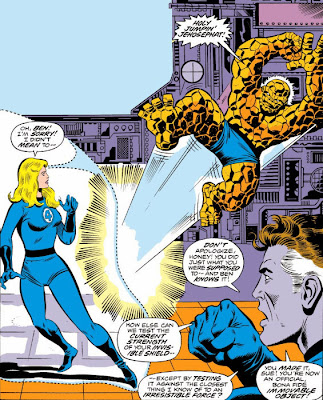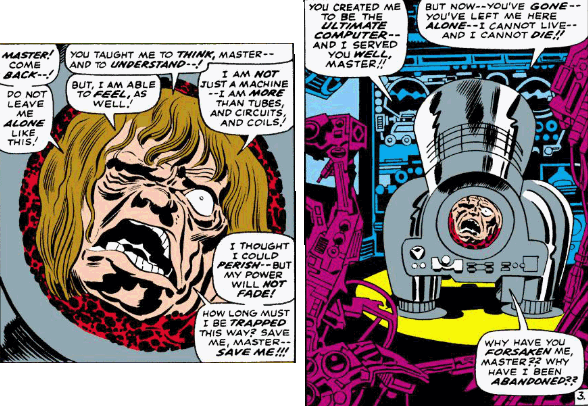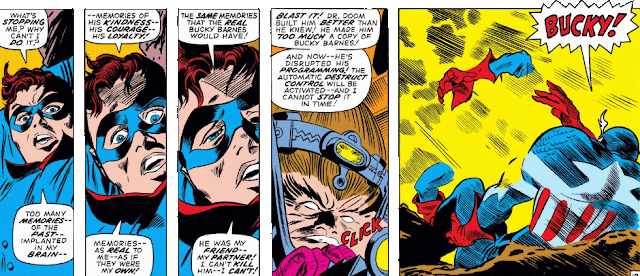I was almost tempted to include this post under a label I've named "
Really?", which groups together some of the stranger match-ups between characters that Marvel occasionally cooked up. But
Silver Surfer #7 isn't really about "The Surfer vs. Frankenstein," which the story first leads us to believe; rather, it had the Surfer contending against the powerful creation which the good doctor brings to life. And before you ask, that creation isn't the "Frankenstein monster" that we typically associate with conflicts which feature that dreaded name, but a creature far deadlier and dangerous. Anything else would have been ludicrous. A battle between the Surfer and the original bolt-necked creature would probably have lasted, oh, about 5 seconds, with the Surfer flying off afterward in bemusement. "These humans," he probably would have said, shaking his head. "What
will they think of next?"
This issue of
Silver Surfer would be the last forty-page issue of the series before the Surfer's adventures would be crammed back into a book half that size, the same number of pages as any other comic book on the rack. It's an experiment I was a little disappointed about seeing come to an end. With far more room to creatively breathe, writer Stan Lee and artist John Buscema did some fine work with the Surfer in those first large-format issues--though with the Overlord story in issue #6, followed by, of all things, an encounter with Frankenstein, it seemed as if the well was running dry rather quickly. So the Surfer's stories returning to standard format might have been wise, at this point. I would have winced, for instance, at the Surfer's battles with
the Human Torch or
the Doomsday Man being dragged out for forty pages--I did
enough wincing, as it was. (On the other hand, you have to wonder if, given the extra pages, Buscema might have given Lee a
lot of good stuff that would have resulted in better stories for those issues.)
For those who remain fascinated with the story of Frankenstein, in all its manifestations in literature, the beginning of this story doesn't disappoint. Given that this is a more contemporary story, we're of course dealing with Frankenstein's ancestor, who is following in his infamous predecessor's footsteps and once again attempting to reanimate the dead. Here, too, the doctor has an assistant--Borgo, who constantly warns his master of the consequences of his actions. For the sake of this story, Lee has made Frankenstein twisted, mad, evil--Magneto with all the trimmings, as he was in his early days of villainy. In fact, in Frankenstein's abusive treatment of Borgo, you'll see Lee and writer Roy Thomas are on the same page in these respective comparisons of how both men deal with their hapless subordinates:
Apparently these villains put little stock in the phrase, "as ye sow, so shall ye reap."
Frankenstein's latest experiment, like his ancestor's, has drawn the attention of the local villagers, who have long memories of the line of Frankensteins who have taken up residence only to put them all in danger. Yet they'll find
this Frankenstein defiant, as well as just a little maniacal:
It looks pretty bad for the doctor. Frankly, as often as that castle has been torched, it's a wonder anything has remained for future Frankensteins to take possession of. But these villagers look like they're going to remedy that situation, once and for all. Fortunately for the doctor, there's a Silver Surfer flying overhead who has spotted the fire and the chaos--and, from the air, all he sees is a mass of attackers attempting to murder two lone victims. So he extinguishes the flames and sends the villagers scattering back, setting the stage for one of the strangest encounters we've seen thus far:
You've probably guessed that our doctor is going to bend the truth just a tad.
Frankenstein puts on his best Sunday manners for the Surfer, whom he's hoping to lure into being the catalyst for "Experiment X," which we'll see in more detail later. But, first, he must get the Surfer to trust him:
(Heh, the kick to Borgo--nice touch by Buscema.)
Thankfully, Lee has the Surfer recall a similar encounter with Dr. Doom, which played out much the same way and which resulted in his being betrayed and captured--so he listens to Frankenstein's honeyed words, but doesn't let down his guard. It was a very appreciated addition to the story; otherwise, I would have thought that Lee was either being incredibly lazy in attempting to rehash the same plot, or that the Surfer would had to have been the most gullible person alive for not noticing the similarities. As it turns out, Frankenstein's performance does him little good--the Surfer hears him out, but his every instinct tells him this guy isn't on the up-and-up, and so he departs, much to Frankenstein's annoyance.
But we've got a
lot of pages to go, so let's not count the doctor out yet. And to prepare, he reviews the prior work of his ancestor, in these nice renderings by Buscema (inked by his brother Sal, I might add):
To make a long story short, our doctor lures the Surfer back with his version of a bat-signal, and again pours on the b.s. about wanting to help others. But he gives the Surfer an added incentive to assist him--the creation of a ray which will drive all evil from the minds of men. The Surfer still doesn't trust this guy as far as he can throw him, but he decides to see it through, surrounding himself with a protective cosmic field just in case.
So, then--welcome to Experiment X:
Quite a twist on Frankenstein's original experiment, as well as a time-saver--creating life from clay. I bet Borgo is glad his days of digging up cadavers are over.
The experiment proceeds, though Frankenstein hasn't informed his helper that, as the clay comes to life, the Surfer consequently begins to die:
Realizing that he's once again been betrayed, the Surfer breaks free in the nick of time. But not in time to prevent Frankenstein from unveiling his first triumph:
Unlike prior experiments from prior Frankensteins,
this creation has total allegiance to his master, as well as no mercy whatsoever--qualities Frankenstein immediately takes advantage of. Now that the real Surfer is presumably slain, the doctor sends his creation to attack the villagers, in a ruthless show of force:
Fortunately, the true Surfer still lives--and, discovering the nature of his counterpart, lures him to space in an attempt to deal with him:
In the meantime, you've gotta hand it to those villagers--they take a licking and keep on ticking. Now motivated more than ever to see an end to Frankenstein as well as to force him to rein in his creation, they swarm on his castle again. Frankenstein, in return, opens fire on them--but the villagers have an unseen ally, one who has finally decided that he's had enough of cowering:
And so another Frankenstein takes the fall. (Ouch--sorry.) But the Surfer's battle with his doppelganger is far from resolved:
Buscema really opens up here, with some beautiful battle scenes which Lee gets right into the spirit of. So why don't I just step aside and let you enjoy these great panels?
Unfortunately, the outside world has only seen the Surfer's attacks on the city, for no apparent reason--and so this story ends with the typical ending we've come to expect from Lee, with the Surfer again being made the outsider who's feared and mistrusted. Though at least Lee doesn't neglect to give us some sort of explanation on just how one Silver Surfer was able to triumph over another:
Bringing to an end a Frankenstein/Silver Surfer story which could have been a
lot worse, but one which turned out to be a fun read as well as a good story from Lee. By the way, in case you were wondering--the Toad was able to take a leaf from Borgo's book and give Magneto a similar reckoning.




































































































































































































